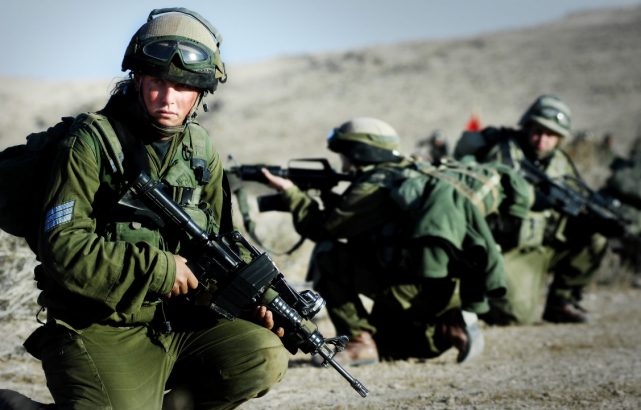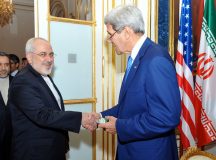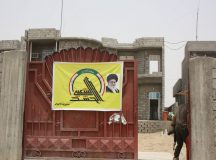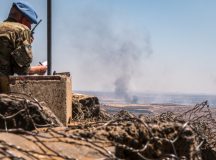Yaakov Lappin is a Research Associate at the Begin-Sadat Center for Strategic Studies, and a military correspondent. In this article he discusses what the Israeli defence establishment calls the ‘war between wars’ – Israel’s campaign is to disrupt attempts by Israel’s enemies to build up their military force on its borders, boost Israeli deterrence, and delay the start of the next full-scale conflict. Over the past 18 months, the Israeli Air Force (IAF) struck no fewer 200 targets across Syria in response to Iran’s drive to turn Syria into a second Lebanon, and create a new Iranian-run army there. Iran is changing its strategy in turn, as Lappin explains. Download a PDF version here.
In late August, Iran’s Defence Minister, Gen. Amir Khatami, met with his Syrian counterpart, Gen. Ali Ayoub, in Damascus and signed an agreement for military cooperation.
This is an event that sounds deceptively mundane. In actuality, it was far from being a routine bilateral defence pact. Instead, it was a statement of Iranian intent – a message Israel paid close attention to – that it has no intention of giving up its goal of turning Syria into an Iranian military fortress in the next phase of an ongoing, explosive regional struggle.
After an extraordinarily effective series of attacks by Israel against its expansion efforts, Iran has had to go back to the drawing board and search for new ways to realise its goal of taking over Syria.
In this fight, Israel is playing an aggressive defence, determined to keep Iran out of all of Syria. Iran is on the offensive, determined to take over Syria militarily, to project its radical power from Tehran all the way to Israel’s border, and convert Syria into an Iranian launch pad for future aggression against Israel.
After turning half of all Syrians into refugees, and killing half a million people, the monstrous Syrian war is drawing to a close, and Iran’s ally, the Bashar Assad regime, has emerged as the de-facto victor, thanks to the assistance it has received from Iranian forces on the ground, as well as Russia air power and diplomatic cover.
Now, Russia’s shift away from Israel and move toward the Assad regime could provide Iran just the encouragement it was seeking to renew its efforts to infiltrate Syria. The Russian – Iranian military alliance, meanwhile, is continuing, despite rising economic rivalry over reconstruction opportunities in Syria. In addition, Iran’s ongoing activities are clashing with Russia’s interest in stabilising and ensuring Assad’s rule for many years to come, by drawing Israeli strikes and creating potential escalation points. What remains unclear is the extent of Russia’s ability or intention to reign Iran in.
The evolution of Iran’s Syrian strategy and Israel’s ‘war between the wars’ doctrine
At first, Iran used Syria mainly as a weapons transit zone. It moved masses of arms, such as surface-to-surface missiles and heavy rockets, surface-to-air missiles, and other arms along a complex trafficking network, which was run by the Islamic Republican Guards Corps (IRGC).
These weapons are produced in Iranian and Syrian factories, and smuggled along air and ground routes into Lebanon. Their final destination was Hezbollah’s storage depots and launch sites, which are embedded in built-up civilian areas across Lebanon. Once in Lebanon, the projectiles are pointed at Israeli cities and critical strategic targets, enabling Iran to threaten the whole of Israel.
Hezbollah’s offensive firepower, estimated at some 150,000 rockets, missiles, and mortar shells, dwarfs that of most NATO member states. According to IDF estimates, one out of three to four buildings in southern Lebanon is a Hezbollah military asset. With Lebanon already an Iranian-run province, the IRGC had hoped that Syria could be next. Under the IRGC’s plan, Syria would not only turn into a mass transit zone for weapons making their way to Hezbollah in Lebanon but would also itself turn into a base for Iranian missile and rocket arsenals, as well as terrorist networks operating under Iran’s command.
But Iran’s weapons trafficking to Lebanon kept running into major trouble. Since 2012, the air strikes that targeting them displayed a high level of intelligence penetration, and accurate firepower, that deeply troubled both Hezbollah and its Iranian patron, causing them to feel exposed.
These strikes evolved into a broad Israeli campaign, dubbed by the Israeli defence establishment as the ‘war between wars’. The aim of this campaign was to disrupt attempts by Israel’s enemies to build up their military force with improved weaponry. It also aimed at boosting Israeli deterrence, and delaying the start of the next full-scale conflict, by making enemies feel vulnerable, and robbing them of their ability to continue to arm themselves with impunity.
In 2017 the war between wars took a new turn. Over the past 18 months, the Israeli Air Force (IAF) struck no fewer 200 targets across Syria – a very high number of active combat operations for so-called ‘routine’ times. Some 800 missiles and bombs were reportedly used in the Israeli attacks – an indication of the sheer scale of Israel’s low-profile operations.
The increase in strikes was due to Iran no longer just using Syria to transit weapons to Lebanon; it also began to turn Syria itself into a second Lebanon and create a new Iranian-run army there.
When the commander of the IRGC’s Quds Force, General Qassem Soleimani tried to respond to Israel’s active defence campaign, by firing a volley of rockets at Israel from a truck-mounted launcher in Syria on 10 May, the IAF decimated over 50 Iranian targets in Syria in retaliation.
Israel’s air operations frustrated Iran’s ambitions for Syria. Relying on the highest quality real-time intelligence and standoff fire capabilities, Israel’s defence establishment was able to place a roadblock in front of Iran’s dangerous regional plot.
An entire IDF doctrine developed to serve this campaign, as the war between wars received growing resources. Long-range precise airpower and ever-improving intelligence capabilities came together to give Israel the ability of placing limitations on Iran’s activities. Israel found that it could enforce its red lines, and that it could do so without ending up in a major war. The ability to identify and track a target, analyse the costs and benefits of striking it, and decide on whether to strike in real time represents a major evolution for the Israeli defence establishment. It enabled Israel to not only enforce its red lines on Iranian expansion, but to also signal powerful regional capabilities, which contributed to deterrence against foes, and inspired Sunni moderate states that are equally threatened by Iran’s activities to boost cooperation with Israel.
But Iran has made it clear that it is not going to walk away so quickly, and that it views these developments as short-term setbacks in a longer strategy.
Iran changes tactics
Iran has flooded Syria with Shi’ite militia forces, weapons, missiles, rockets, and drones and established military bases as well, rather than making due with proxy forces. Yet as noted, Tehran’s takeover plans for Syria were severely frustrated by persistent and effective Israeli preventative action. As a result, the Iranians appear to be changing tactics.
The defence pact signed on 26 August by the Assad regime and the Islamic Republic is one component of these new tactics, which suggest Iran will try to disguise its future activities in Syria by blending in deeply with Assad’s military, and with the Syrian weapons industry.
Clues to this new Iranian approach could be found in the comments of Iran’s defence minister during his meeting in Damascus. Gen. Khatami in which he stated that ‘Iran hopes to take an active part in rehabilitating Syria,’ adding that the purpose of the agreement was to upgrade the cooperation between the countries ‘as Syria begins the stage of building and rehabilitation’. It appears that Iran is looking to ‘cash in its chips’ from its intervention in Syria’s civil war – an intervention that has been costly to Iran, in both blood and treasure.
It seems highly likely that Iran also wants to take an active role in rebuilding Syria’s decimated military, and in the process, installing its own weapons factories, personnel, and bases in the country. Tehran is seeking to amalgamate its activities with the Syrian army and state. That, Iran seems to hope, will make it harder for Israel to stop it.
Khatami also vowed that ‘no third country’ will have an impact on the presence of Iranian ‘advisors’ on Syrian soil.
In addition to trying to merge with the Syrian military, Iran seems to be trying a few more tricks. These include using Iraq, also under considerable Iranian influence, as an area to store Iranian missiles, away from the exposed Syrian arena. This would presumably involve utilising Iran’s Iraqi-Shi’ite militias for the trafficking and storage of such weapons.
On 31 August, the Kurdistan 24 news services reported mysterious blasts at weapons warehouses in the Iraqi city of Karbala that belong to Iranian-backed militias operating under the Popular Mobilisation Front (PMF) umbrella organisation. They cited the PMF as saying that it spotted drones in the area prior to the blasts, and that the aircraft were ’unfriendly’.
Iran’s reliance on Iraqi militias to move and store weapons in the region appears to be putting the militias at risk. In June this year, air strikes targeted the town of Al-bukamal, on the Syria-Iraq border, reportedly causing a large number of casualties among Shi’ite-Iraqi militias in the area, and destroying structures.
That may have been a strike on a new Iranian attempt to link up the Iraqi and Syrian arenas with a land bridge, enabling forces under Iran’s command to move personnel and arms freely. The air strikes, then, could be one of the latest instalments in this ’cat-and-mouse’ campaign.
Can an Israeli-Iranian major escalation be prevented?
Israel’s response to these developments was summed up by Prime Minister Benjamin Netanyahu, who spoke three days after the Damascus meeting. Delivering a speech at the Dimona Nuclear Research Center, Netanyahu declared: ‘We are acting to prevent the military establishment of Iran in Syria. We will not give up on this objective.’ He added that the ‘IDF will continue to act, with full determination, and full force, against Iran’s efforts to deploy forces and advanced weapons in Syria. And no agreement between Syria and Iran will deter us’.
So far, Tehran and Jerusalem have been able to mostly keep this conflict on low flame, but there are no guarantees that they can avoid a major escalation in the future. Netanyahu’s comments indicate that Israel has no intention of being given a role in an Iranian screenplay. That means Israel will not hesitate to launch attacks on the Assad regime’s military sites that have been infiltrated by the Iranians, if intelligence points to a need to do so.
The mysterious car bomb assassination of the head of Syria’s missile programme, Dr Aziz Asbar, who reportedly maintained a very close working relationship with his Iranian missile programme counterparts, could be an indication of Israel’s future responses to Iran’s new tactic.
So too could a wave of reported Israeli airstrikes conducted on Syrian weapons research and development sites, and Iranian targets in Syria on 4 September.
If so, Iran’s actions are placing the Assad regime’s victory in jeopardy. As the war nears its final chapter, Assad will likely turn his focus toward the mammoth task of reconstruction, and would presumably not want to be dragged into a war with Israel, or to be more collateral damage for further Israeli-Iranian confrontations in his country. But Iran seems prepared to take such risks, and so long as it can secure approval from Damascus for its activities, it will continue to try and consolidate itself in Syria.
Israel and Russia: Deconfliction under threat?
In the midst of these events, Israel has been able to maintain a good understanding with Russia, but that understanding now appears to have broken down and replaced with a major crisis, following the shooting down of a Russian intelligence-gathering aircraft by Syrian air defence units that were trying to hit Israeli jets.
The incident, which led to Moscow announcing a transfer of the S-300 air defence system to the Assad regime, and a public series of threats and rebukes from the Russian Defence Ministry against Israel, was sparked by just the kind of Iranian activity described above – using a Syrian military facility to house and traffic powerful Iranian weapons. The facility targeted by the IDF in Latakia, on the Syrian coastline, located 25 kilometres north of a Russian airbase, was housing manufacturing kits for precision missiles, which Iran had planned to smuggle to Hezbollah in Lebanon.
The fallout from the incident looks severe, with Russia perceiving Israel’s strike as going a ‘step too far,’ and seeking to deter it by placing S-300 systems – presumably with Russian personnel operating them in the first phase – at the disposal of the Assad regime, which has been eyeing a purchase of the system for several years.
To date, the Assad regime’s other Russian-made air defence systems, such as the older SA-5, SA-17, and SA-22 systems, have presented serious challenges to the IAF’s operations, but the IAF has evolved to overcome them. In addition, the IAF appears to have evolved to be able to operate out of sight of the S-300, as well as its more advanced version, the S-400, which has already been deployed to Syria by Russia to protect Russia’s airbase at Khmeimim and port at Tartus. In fact, it was the possession of the S-300 by Iran, which uses the batteries to protect its nuclear sites, that was another catalyst that drove Israel to study the system closely. These developments suggest that the IAF is well prepared for the additional challenge posed by the transfer of the S-300 to the Assad regime.
Yet despite the ongoing crisis with Russia, Netanyahu and Israeli defence officials have indicated through statements that Israel’s war between wars against Iran in Syria is not about to come to a stop.
The deconfliction mechanism continues to exist between Moscow and Jerusalem at the highest levels down to the lowest operational ranks, and Russia seems to be well aware that Israel’s red lines are directed only against Iran and its proxies, not against Moscow.
Nevertheless, Russia’s advanced military presence in the region, which includes powerful radars and air defence systems, has forced Israel to find new ways to operate, to ensure that it can keep the element of surprise. This factor has forced the IAF to improve, making it ready to continue to operate despite the new crisis with Russia.
Russia remains concerned about the possibility of an escalation – a ‘spark’ that could end up igniting the region and which could ultimately jeopardise the existence of the Assad regime, which Russia has invested much in to rescue as part of the new Russian drive to reinvent itself as a global power that rivals the US.
The potential remains for conflict to develop uncontrollably from any incident. A resulting potential war could destroy the Assad regime, and set off an Hezbollah-Israel war in the process.
While no side seems interested in such a scenario at this time, and Iran has shown an ability to march to the brink without going over the edge, the danger of unintended consequences always remains.
The Russians, for their part, are keen on capitalising on their intervention in Syria to build up their abilities as a world power, and to oversee Syria’s rehabilitation. A regional war between Israel and the Iranian axis fought in Syria is the last thing Russia would want to see.
Russia had previously attempted to ease Israeli-Iranian tensions by offering to move Iranian personnel back from the Israeli border, but Iran’s embed tactics with Syrian forces has already seen pro-Iranian militia forces move into southern Syria, close to Israel, together with Assad’s army, to seize the last remaining rebel strongholds in that area.
Russia seems set on trying to continue to douse the flames, and keep Iran and Israel apart, but its ability to do this has been very limited.
The Americans are staying … for now
The Trump administration, for its part, appears to have been influenced by the position of the Pentagon, and has walked back its call to pull out the 2000 American troops guarding the Syrian-Iraqi border. Their presence has helped block Iran’s land bridge aspirations.
The US is reassessing its role in Syria, after two consecutive American administrations – Obama and Trump – have effectively abandoned the Syrian arena to Russia and Iran, and focusing exclusively on the mission of destroying ISIS.
It remains unclear how the US will act in Syria in the future. So far, there has been no major change in the US’s approach to Syria under the Trump administration, which is continuing to focus on the threat from ISIS, and taking little discernible action on the ground to deal with the Shi’ite-Iranian axis, or to push back against Russia’s domination of the Syrian arena. Washington is attempting to improve its regional posture in a minor fashion. Issuing warnings about the use of further chemical weapons by the Assad regime, and keeping a small contingent of soldiers on the Syrian-Iraqi border, is one example of this.
Israel, for its part, is counting on no one to roll back the Iranians in Syria other than itself.
Still, action taken by the US could influence Iran’s future decision making on Syria. Iran is dealing with an increased strain on its economic resources, due to the sanctions re-imposed on it by the Trump administration. Nevertheless, Iran’s recent actions have demonstrated that its regional aspirations, the goal of territorial expansion, and creating the ability to attack Israel from Syria remain top priorities. It is prepared to invest in these high-cost activities even when the Iranian economy is crumbling. So long as this remains the case, Israel’s defence establishment will have its work cut out for it in containing the Iranian challenge.
Israel is determined to do whatever is necessary to prevent Iran from creating a second Iranian division in Syria, alongside its primary military division in Lebanon. Ultimately, Iran’s actions cannot be understood as anything other than an aggressive threat to Israel’s security, a threat that would clearly metastasise and turn the whole of the northern front into an intolerable threat to Israel’s home front, if left unchecked.
So far, Israel has been able to deal with this threat preventatively, protect its national interests, and place constraints on the Iranian expansion programme without being dragged into a full-scale war.
The coming months and years will reveal whether this achievement can repeat itself, in light of Iran’s changing tactics.






































Comments are closed.